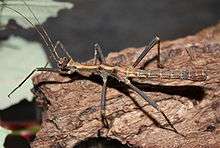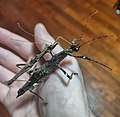Sungaya
Sungaya inexpectata is a species of stick insect. Its common name is the sunny stick insect, derived from the less commonly used sungay stick insect. It is a species in the order of the stick insects Phasmatodea and the only member of the genus Sungaya. The genus name refers to the locality of the holotype, i.e. the region where the insect was first identified. The species name is derived from the Latin as "inexpectatus" and means "unexpected".[1]
| Sunny stick insect | |
|---|---|
 | |
| A male sunny stick insect | |
| Scientific classification | |
| Kingdom: | |
| Phylum: | |
| Class: | |
| Order: | |
| Superfamily: | Bacilloidea |
| Family: | |
| Genus: | Sungaya Zompro, 1996 |
| Species: | S. inexpectata |
| Binomial name | |
| Sungaya inexpectata Zompro, 1996 | |
Discovery and occurrence
Oliver Zompro collected the first specimen of this species, a nymph, on 8 September 1995 in Baranggay Sungay in the province of Batangas-associated township Talisayon on the Philippine island of Luzon. She died a short time later due to a failed molting during transport. On October 7, 1995, he was almost at the same location where he collected an adult female, which he described in 1996 as the holotype of the species, and which is currently located at the Zoological Museum at the University of Kiel. Zompro discovered more females in 1999 near the Taal Lake.[2] The first males were discovered in 2008 by Orlando L. Eusebio, SA Yap and AR Larona, also on Luzon, more precisely at Mount Cayapo of the Mariveles Mountains in Baranggay Alangan in of the province of Bataan in the associated township Limay.[3]
Features
The species is sexually dimorphic, with females larger than the males. The females reach a length of 80 to 85 millimeters and a weight of about five grams. The males are leaner and significantly smaller at 50 to 56 millimeters in length.
The coloring of the females is fairly varied. The females tend to have more contrasting colors, with areas of dark brown, light brown and black, with white bands on the legs and/or body. Particularly striking are females with a white vertical line over the entire body. Rarely, there are females in which green tones dominate the basic color. The males tend to be light brown or medium brown and have on the mesonotuman and metanotuman a sometimes indistinct, wide longitudinal line that may be, depending on the base color, a dark brown on light background or light brown on dark background.[3]
Both sexes are wingless and have relatively short and blunt spines, with particularly the spiked crown on the back of the head and the four spines on mesonotum and metanotum. These are slightly pointed and especially sharp in the females.
At the end of the female's abdomen, they have a beaked secondary ovipositor, which surrounds the primary ovipositor.[4]
Reproduction
The species reproduces both sexually and by parthenogenesis. The first offspring of a wild-caught animal will lay eggs about 4.5 millimeters long and 3.7 millimeters wide, in groups of 10 to 12, approximately every two weeks. Later generation lay their eggs individually into the damp earth. Meanwhile, females are known to leave their eggs just fall to the ground. After 4 to 6 months the nymphs hatch which are 17 millimeters long at hatching.[5] While the nymphs of the original strain, as well as their fresh adult females, are very bright, the newly hatched nymphs of sexually propagated animals are often colored dark gray instead. Later, they show a remarkable color variability from molt to molt, especially the female nymphs. The entire development from first instar to adult takes about three to four months.
Captivity
The first of the adult wild-caught females captured by Oliver Zompro lay only four eggs before it died. From these three hatched nymphs, two of which grew into adult females. For years, the entire culture was produced asexually from these females. This first breeding stock is now referred to as "Highland" shape. In 2008 a new colony was started with males introduced, and these are referred to as the "Lowland" shape.[5]
The animals need temperatures of 22 to 27 °C and a humidity between 60 and 80 percent. They are most active at night. During the day they sit camouflage themselves on their food plants, which preferably have similar colors as the animals themselves. Their food plants should be kept in narrow-necked vases in the terrarium and placed about every two days sprayed with water using a spray bottle. They primarily eat bramble, although they can also feed on Hawthorn and other deciduous plants. For oviposition, a good five inches high layer of damp humus-sand mixture should cover the ground. The eggs can be left in the ground or for better control can be transferred to a simple incubator.[4][6]
Gallery
 Eggs
Eggs Nymph
Nymph- A variety of males and females
- Captive green females
 Male of the species
Male of the species Older wildtype female
Older wildtype female Sungaya inexpectata adult pair
Sungaya inexpectata adult pair
References
- Oliver Zompro: Bemerkungen über philippinische Obrimiden, mit einer Neubeschreibung (Phasmatodea: Heteropterygidae: Obriminae). Entomologische Zeitschrift (1996 b) 106 (11): 450-456.
- Oliver Zompro: Zur Entdeckung von Sungaya inexpectata Zompro, 1996, Arthropoda 16 (2) August 2008, Sungaya-Verlag Kiel. ISSN 0943-7274
- Dr. Ireneo L. Lit jr. & Orlando L. Eusebio: First description of the male of Sungaya inexpectata Zompro, 1996 (Phasmatodea: Heteropterygidae: Obrimini), Arthropoda 16 (2) August 2008, Sungaya-Verlag Kiel. ISSN 0943-7274
- Christoph Seiler, Sven Bradler & Rainer Koch: Phasmiden - Pflege und Zucht von Gespenstschrecken, Stabschrecken und Wandelnden Blättern im Terrarium - bede, Ruhmannsfelden 2000, ISBN 3-933646-89-8
- Oliver Zompro: Gespenstschrecken der Familie Heteropterygidae im Terrarium - Reptilia - Terraristik Fachmagazin (Nr.24, August/September 2000) Natur und Tier, Münster 2000
- Oliver Zompro: Grundwissen Pasmiden – Biologie - Haltung - Zucht. Sungaya Verlag, Berlin 2012, S. 71, ISBN 978-3-943592-00-9